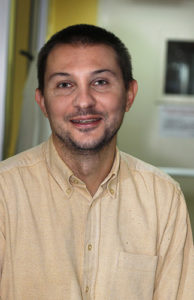Bio
Enrico Ragni graduated in 2001 in Biological Sciences with magna cum laude (University of Milan). Habilitation for Biologist profession was acquired in 2002. PhD in Cellular and Molecular Biology (Excellent) in 2005 (University of Milan). From 2004 to 2006 he worked as PostDoc at HIP Department of Heidelberg University with a grant for Promising Young Researchers (University of Milan) and a fellowship founded by EC (FP6 Life Sciences – Fungwall Project), acquiring strong experience in microbiology. From 2006 to 2011 he held the position of Research Fellow at University of Milan, with interest in the biology of pathogenic fungi. In 2007 he was awarded a FEMS Young Scientist Scientific Grant. He held a teaching position in “Laboratory of Experimental Biology II” (2002/2004 and 2006/2010 at University of Milan). From 2011 to 2016 he worked as Researcher at Cell Factory Milano under EC programs (FP7 Health – Cascade and Reborne Projects), with main interest in human mesenchymal stem cells. From 2016 and 2017 he held the position of Research Fellow at University of Milan. From 2017 he works as Researcher at Orthopaedic Biotechnology Laboratory (IRCCS Istituto Ortopedico Galeazzi), focusing his attention at regenerative potential of molecules secreted by stem and progenitor cells applied to the orthopedic field.
Publications
Ragni E, Banfi F, Barilani M, Cherubini A, Parazzi V, Larghi P, Dolo V, Bollati V, Lazzari L. Extracellular vesicle-shuttled mRNA in mesenchymal stem cell communication. Stem Cells. 2017 Apr;35(4):1093-1105. doi: 10.1002/stem.2557.
Conti A, Rota F, Ragni E, Favero C, Motta V, Lazzari L, Bollati V, Fustinoni S, Dieci G. Hydroquinone induces DNA hypomethylation-independent overexpression of retroelements in human leukemia and hematopoietic stem cells. Biochem Biophys Res Commun. 2016 Jun 10;474(4):691-695. doi: 10.1016/j.bbrc.2016.05.010.
Montemurro T, Viganò M, Ragni E, Barilani M, Parazzi V, Boldrin V, Lavazza C, Montelatici E, Banfi F, Lauri E, Giovanelli S, Baccarin M, Guerneri S, Giordano R, Lazzari L. Angiogenic and anti-inflammatory properties of mesenchymal stem cells from cord blood: soluble factors and extracellular vesicles for cell regeneration. Eur J Cell Biol. 2016 Jun-Jul;95(6-7):228-38. doi: 10.1016/j.ejcb.2016.04.003.
Barilani M, Lavazza C, Boldrin V, Ragni E, Parazzi V, Crosti M, Montelatici E, Giordano R, Lazzari L. A chemically defined medium-based strategy to efficiently generate clinically relevant cord blood mesenchymal stromal colonies. Cell Transplant. 2016;25(8):1501-14.
Ragni E, Lommel M, Moro M, Crosti M, Lavazza C, Parazzi V, Saredi S, Strahl S, Lazzari L. Protein O-mannosylation is crucial for human mesenchymal stem cells fate. Cellular and Molecular Life Sciences. 2016 Jan;73(2):445-58. doi: 10.1007/s00018-015-2007-y.
Montelatici E, Baluce B, Ragni E, Lavazza C, Parazzi V, Mazzola R, Cantarella G, Brambilla M, Giordano R, Lazzari L. Defining the identity of human adipose-derived mesenchymal stem cells. Biochem Cell Biol. 2015 Feb;93(1):74-82. doi: 10.1139/bcb-2014-0094.
Ragni E, Parazzi V, Crosti M, Moro M, Giordano R, Lazzari L. Diet composition transiently modulates proliferative and potency features of human cord blood-derived mesenchymal stem cells. IJBCB. 2014 Oct;55:269-78. doi: 10.1016/j.biocel.2014.09.017.
Ragni E, Viganò M, Parazzi V, Montemurro T, Montelatici E, Lavazza C, Budelli S, Vecchini A, Rebulla P, Giordano R, Lazzari L. Adipogenic potential in human mesenchymal stem cells strictly depends on adult or fetal tissue harvest. IJBCB. 2013 Nov;45(11):2456-66. doi: 10.1016/j.biocel.2013.07.024.
Ragni E, Montemurro T, Montelatici E, Lavazza C, Viganò M, Rebulla P, Giordano R, Lazzari L. Differential microRNA signature of human mesenchymal stem cells from different sources reveals an “environmental-niche memory” for bone marrow stem cells. Exp Cell Res. 2013 Jun 10;319(10):1562-74. doi: 10.1016/j.yexcr.2013.04.002.
Ragni E, Viganò M, Rebulla P, Giordano G, Lazzari L. What is beyond a qRT-PCR study on mesenchymal stem cell differentiation properties: how to choose the most reliable housekeeping genes. J Cell Mol Med. 2013 Jan;17(1):168-80. doi: 10.1111/j.1582-4934.2012.01660.x

